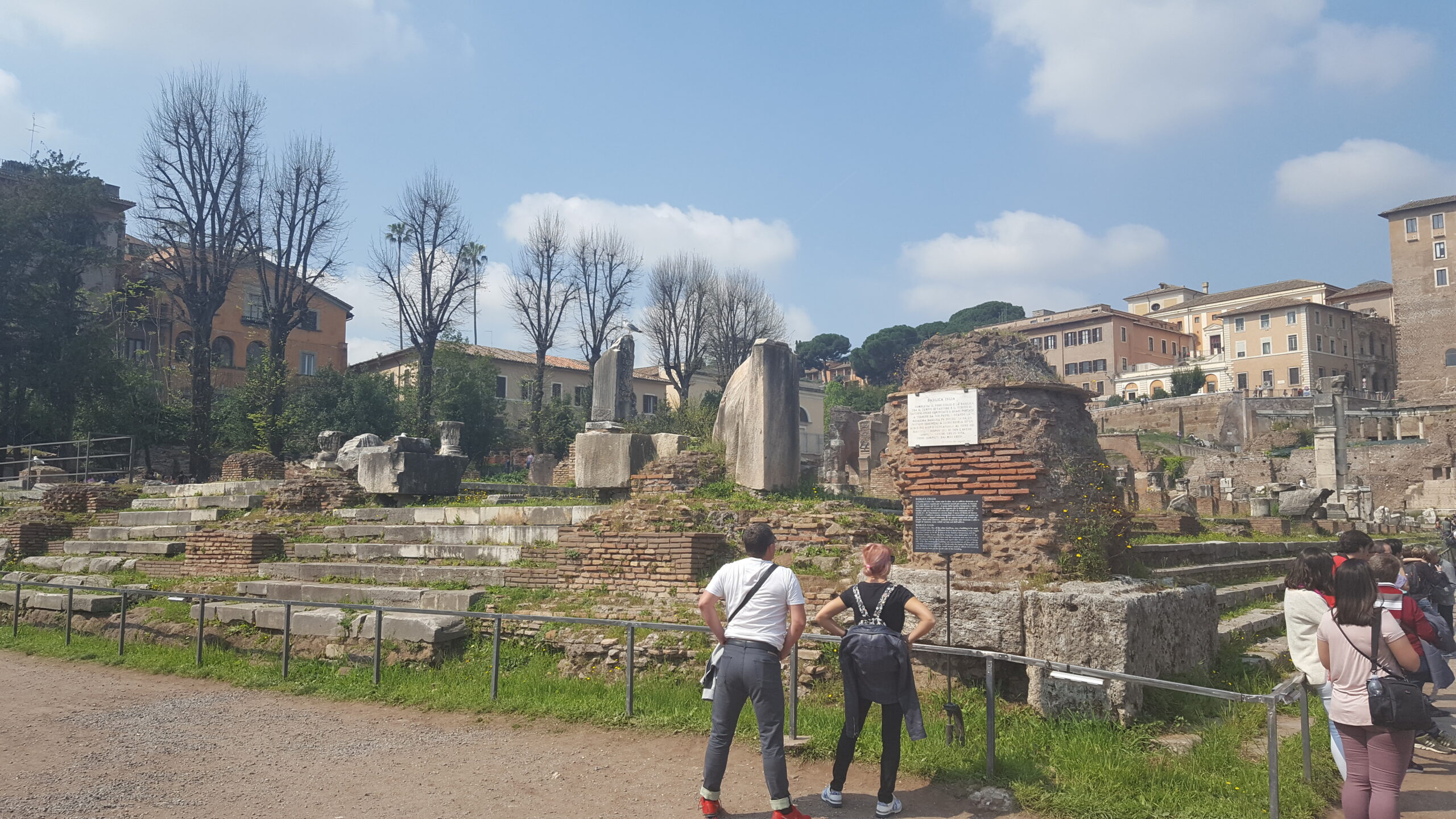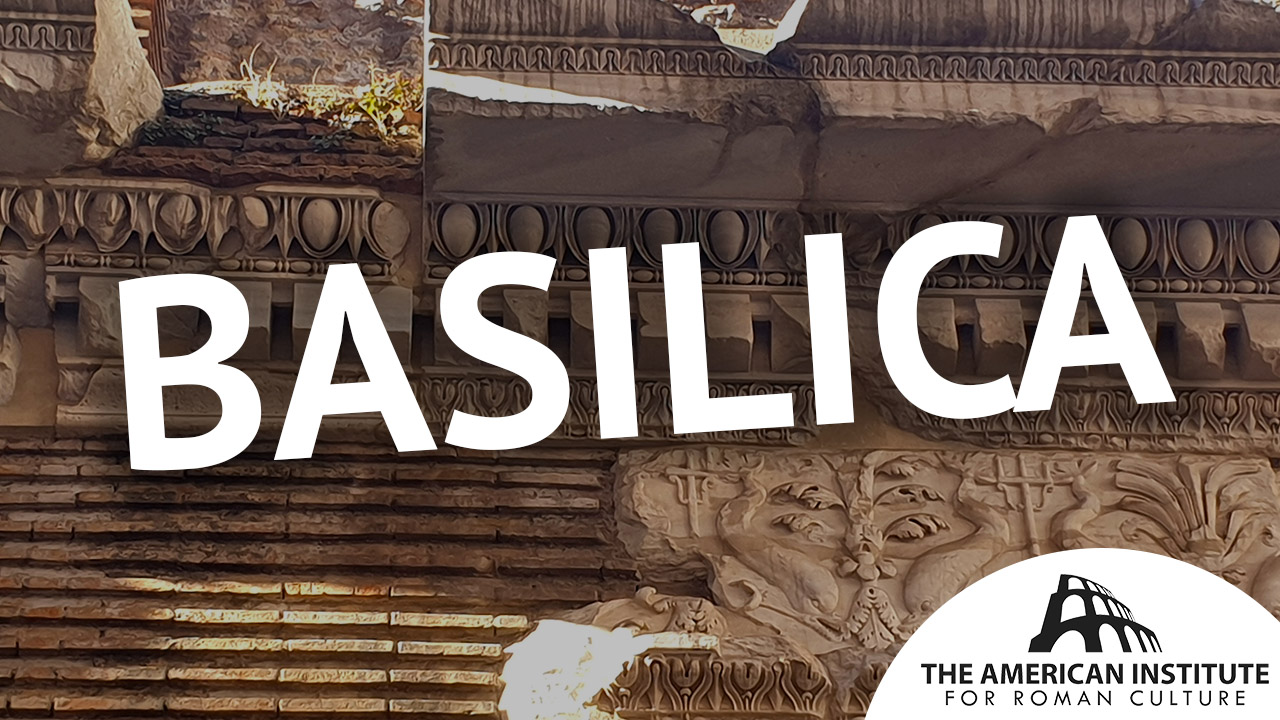Start with our video overview:
Construction of the Basilica Julia began under Julius Caesar in 46 BCE, and was not finished until the reign of Augustus. The Basilica Julia sat on the south side of the Forum, with the roads vicus Tuscus and vicus Jugarius running on either side of the building. It was built on the site of the Republican-era Basilica Sempronia, which was torn down by Caesar in 54 BCE so he could build the Julia. With Caesar being assassinated on the Ides of March in 44 BCE, he wouldn’t have seen much of the construction completed before his death. In 12 BCE, Augustus finished the construction and dedicated it to Caesar, his great-uncle and adoptive father.
The Basilica Julia housed the civil law courts, tabernae (shops), as well as space for government offices and banking. Later, the Centumviri (Court of the Hundred) used the basilica for their sessions presiding over inheritance cases. Unfortunately, the Basilica Julia burnt down in 9 CE. It was rebuilt over three years, and in 12 CE it was re-dedicated to Gaius and Lucius Caesar, Augustus’ deceased nephews and heirs. Despite this re-dedication, it was still known as the Basilica Julia by the poets Martial (Epigrams VI.38.6) and Statius (Silvae I.1.29). No expense was spared in its construction. The Basilica Julia was decorated from top to bottom in fine marble from across the empire, and its columns were made from Italian Carrara marble.
During the reign of Carinus in the Crisis of the Third Century, the Basilica was damaged by fire, but was restored by Diocletian, before a final restoration in 416 CE by the Prefect of the City, Gabinius Vettius Probianus.
Suetonius tells us that Caligula enjoyed showering crowds with money from the roof of the Basilica (The Twelve Caesars, Caligula, 37). There is also evidence of gaming spaces on the steps of the Basilica (Mitt 1896 and H. Thédenat 1904).
Following the sack of Rome, the basilica was heavily mined for its marble, so much so that a lime kiln was discovered on site.
In the seventh or eighth centuries, part of the Basilica was converted into a church, thought to be Santa Maria di Cannapara (Hülsen 1927), while marble workers took up much of the remaining space. By the 16th century, the Basilica was buried under sediment and debris. The space was used to bury deceased patients of the Ospedale della Consolazione, which sat just outside the forum.
Bibliography:
Arya, Darius. (2024). “Basilica (General).” Ancient Rome Live. https://ancientromelive.org/basilica-general/
Grout, James. (n.d). “Basilica Julia.” University of Chicago. https://penelope.uchicago.edu/encyclopaedia_romana/romanforum/julia.html
Platner, Samuel. (1929). “Basilica Julia.” In A Topographical Dictionary of Ancient Rome (p.78-80). Retrieved from: https://penelope.uchicago.edu/Thayer/E/Gazetteer/Places/Europe/Italy/Lazio/Roma/Rome/_Texts/PLATOP*/Basilica_Julia.html
Basilica Iulia: on the south side of the forum, between the vicus Tuscus and the vicus lugarius. It was perhaps begun by Aemilius Paullus on behalf of Caesar, probably in 54 B.C. (cf. the difficult passage Cic. ad Att. IV.16.8, a letter written in that year, and the commentators, especially Becker, Top. 301‑306; Jord. I.2.394; and contrast AJA 1913, 25, n2), dedicated in an unfinished state in 46 ( Hier. a. Abr. 1971), completed by Augustus, burned soon afterwards, and, when p79 rebuilt in an enlarged form by Augustus, dedicated again in 12 A.D. in the names of Gaius and Lucius Caesar; Cass. Dio LVI.27:1.
Read more:
It is not certain, however, that the building was entirely finished when dedicated for the second time (cf. Mon. Anc. loc. cit.). It was injured by fire under Carinus (Chron. p148) and restored by Diocletian (ib.), and again in 416 A.D. by a certain Gabinus Vettius Probianus, prefect of the city, who also adorned it with statues (CIL VI.1156, 1658, 31883‑31887; NS 1883, 47‑48; Mitt. 1902, 54; Klio, 1902, 269‑270). Notwithstanding its dedication under the names of Gaius and Lucius, it appears as the basilica Gai et Luci only in the three passages quoted above, and elsewhere as basilica Iulia, or tecta Iulia in the poets (Mart. VI.38.6; Stat. Silv.I.1.29). Its site is definitely described by ancient authorities (Mon. Anc. loc. cit.; Fest. 290; Stat. loc. cit.), and it is represented on the Marble Plan (frgs. 20, 23). From its roof Caligula threw coins among the people;; Joseph. XIX.11.1.11; cf. Mitt. 1893, 264; Chron. p145; JRS 1926, 134).
During the early empire the centumviral court held its sessions in this basilica (Mart. VI.38.5‑6; Plin. Ep. reference Latin Library; and a statue of Crispus was set up here as a reward for his frequent pleadings before the Emperor Domitian (Schol. Iuv. 4.81). The basilica is mentioned in several inscriptions (CIL VI.9709, 9711, 9712, 32296), in Reg, and by Pol. Silv. The amount and magnificence of the marble used in this basilica marked it as the special prey of the vandals of the middle ages, and a lime kiln was found on its very pavement (LD passim; BC 1891, 229‑236). In the seventh or eighth century the outer aisle on the west side was converted into a church (Archivio Storico dell’ Arte, 1896, 164; Frothingham, Monuments of Christian Rome (New York 1908) 83); this has generally been identified with S. Maria de Cannapara, mentioned in the catalogues of the twelfth to fifteenth centuries, which must, however, have been at a considerably higher level. Nor can it be S. Maria in Foro; cf. HFP 15.
The basilica occupied a space 101 metres long and 49 wide, bounded on all sides by streets, the Sacra via, the vicus lugarius, the vicus Tuscus, and a street on the south connecting the last two. In the later restorations the material of construction, but not the form, was changed (CR 1901, 136; Mitt. 1902, 60). The central court, 82 metres long and 16 wide, was surrounded on all sides by two aisles, 7.50 metres wide, over which were the galleries of a second story (cf. Plin. Ep. VI.33; reference Latin Library). These aisles were formed by the pillars of the façade, which were of marble, and by inner rows of similar pillars made of brick and faced with marble. The first floor of the basilica was therefore an open arcade, divided by the marble balustrades which joined the pillars. Of these pillars there were eighteen on each of the longer sides, and eight, counting the ends of the spur walls, on the shorter. The entire outside of the p80 building was constructed originally of white marble, and on the outer faces of its pillars were engaged columns of the Doric order. The floor sloped slightly towards the north-east corner, and was paved with slabs of marble, coloured in the central court and white in the aisles. The central area was covered with a wooden roof (reference Latin library, Mart. VI.38.6), which rose above the roof of the side aisles and admitted light through its side windows, as in the basilica Aemilia. For the fragments of the vaulting of the side aisles, see Mitt. 1901, 13‑18.
A continuous flight of three steps leads down from the floor of the central court to that of the outer aisle in front, which, being lower, forms a sort of portico. From this aisles steps again lead down to the street, but as there is a considerable rise in the Sacra via, there are seven steps at the east end and only one at the west. On the south side was a row of rooms opening on the street, some of which, with massive tufa walls, have only been partially excavated. It is possible that there was a row of tabernae on this, the sunny side, as in the basilica Aemilia; there are traces of stairs ascending to an upper level, i.e. to the roof of these tabernae.
The existing remains consist of the foundation, with fragments of the marble pavement on which are inscribed upwards of eighty tabulae lusoriae (Mitt. 1896, 227‑252); the steps with portions of the marble casing; and on the vicus Iugarius some of the brick pillars and arches of the outer aisles belonging to the restoration of Diocletian, together with some fragments of the marble pillars of the outside. Against the second column from the front, on the west end, a heavy pier was built, which formed part of an arch across the vicus Iugarius. Some architectural fragments have been found, but the standing column of travertine and many of the brick piers are modern (Jord. I.2.385‑391; Théd. 150‑153, 218‑223; LS II.205‑206; LR 275‑279, with résumé of excavations since 1496; RA 202‑205; DR 408, 419; RE Suppl. IV.466‑469; ASA 83).
This content is brought to you by The American Institute for Roman Culture, a 501(C)3 US Non-Profit Organization.
Please support our mission to aid learning and understanding of ancient Rome through free-to-access content by donating today.
Cite This Page
Cite this page as: Darius Arya, The American Institute for Roman Culture, “Basilica Iulia (Basilica Julia)” Ancient Rome Live. Last modified 05/15/2025. https://ancientromelive.org/basilica-iulia-basilica-julia/
License
Created by The American Institute of Roman Culture, published on 05/15/2025 under the following license: Creative Commons: Attribution-NonCommercial-ShareAlike. This license lets others remix, tweak, and build upon this content non-commercially, as long as they credit the author and license their new creations under the identical terms. Please note that content linked from this page may have different licensing terms.




